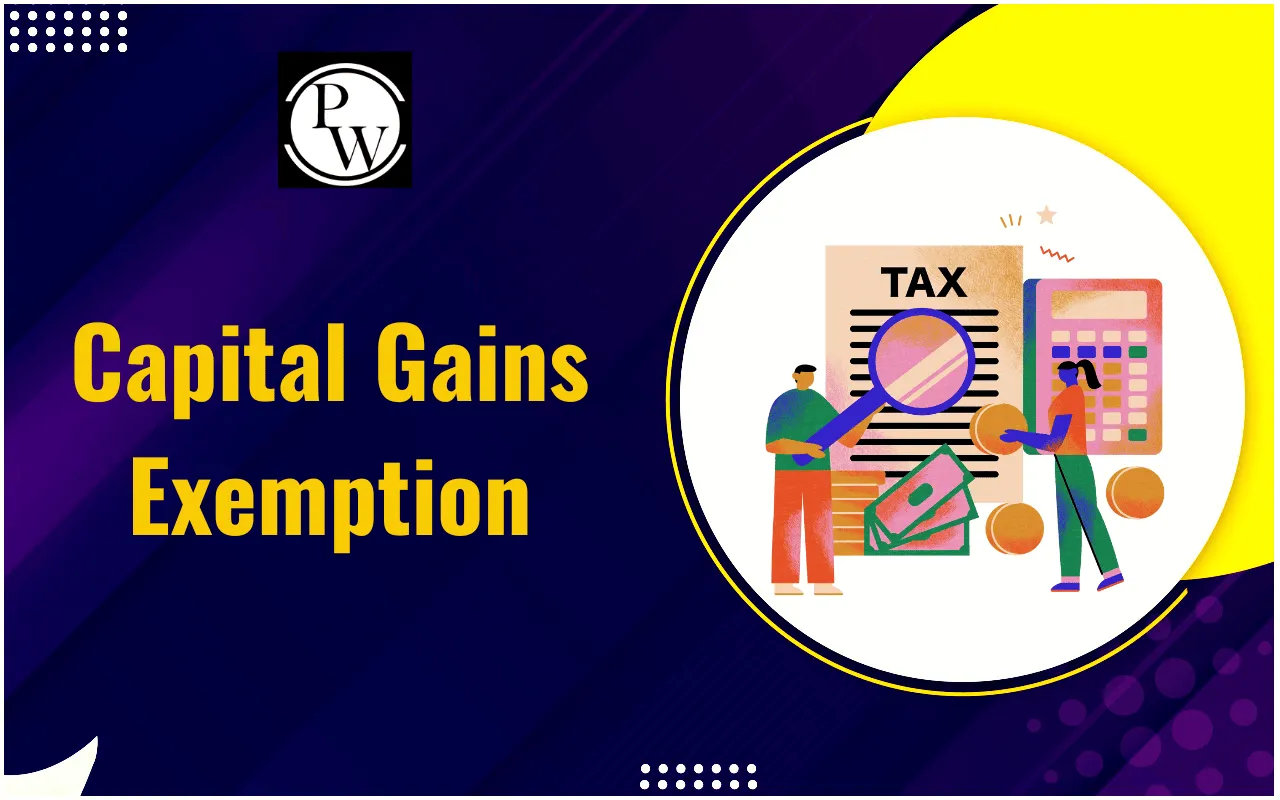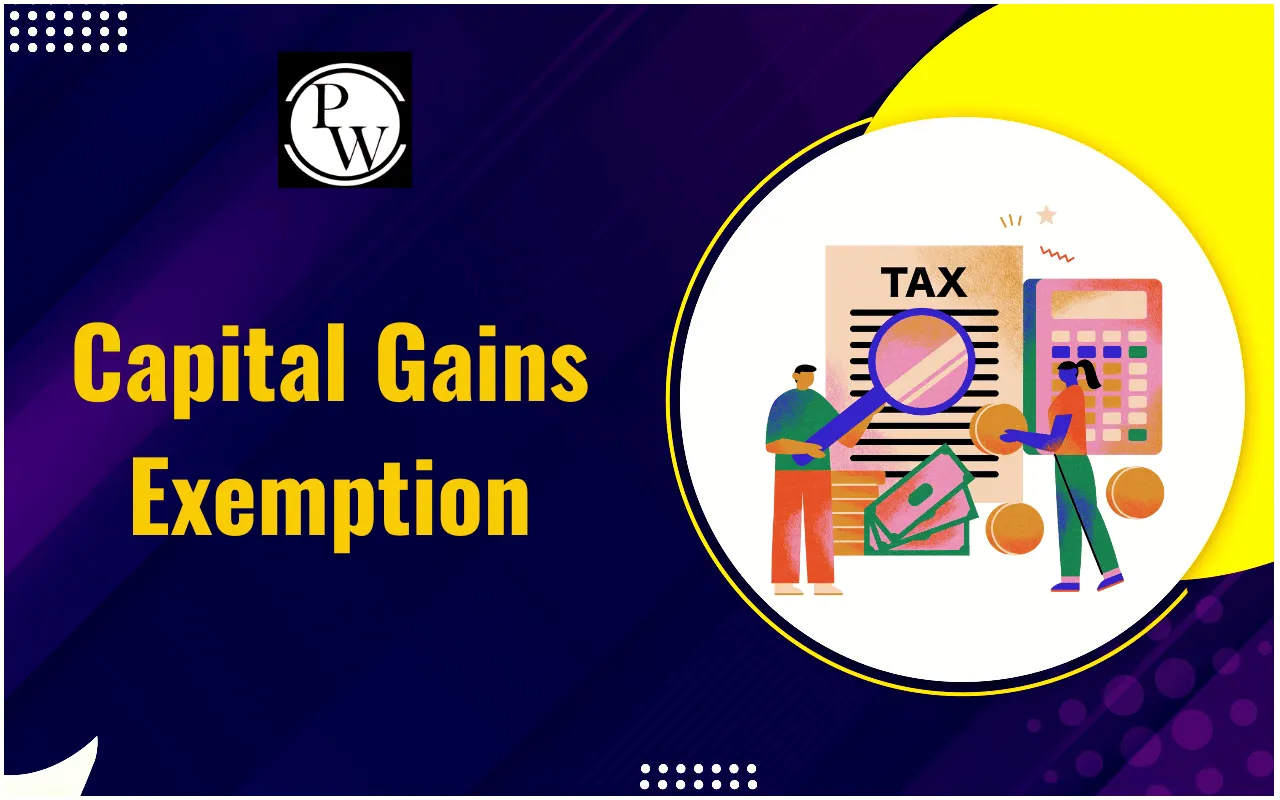

Capital gains exemption relates to the benefit you can claim on the profit earned after selling assets. These assets may be something related to property, gold, or shares. This gain is subject to capital gains tax under the Income Tax Act, 1961. However, the government provides different provisions. These provisions are known as the Capital Gains Exemption. It allows taxpayers to save or reduce this tax liability by reinvesting the capital gain amount in new assets.
Having knowledge about these exemptions is very important for effective financial planning. This knowledge is especially useful for students and aspirants who are preparing for exams. The exams that cover tax and finance allow tax-free growth of wealth. Here, we will mention the major exemptions available under different sections of the Income Tax Act.
Capital Gains Exemption Overview
Most exemptions depend upon their terms, especially short-term or long-term. This classification is determined by the holding period of the asset before its transfer.
|
Capital Gains Exemption Overview |
||
|
Particular |
Short-Term Capital Asset (STCA) |
Long-Term Capital Asset (LTCA) |
|
Listed Equity Shares/Equity MF |
Held for less than 1 year |
Held for more than 1 year |
|
Land or Building, Unlisted Shares |
Held for less than 2 years |
Held for more than 2 years |
|
Other Capital Assets |
Held for less than 3 years |
Held for more than 3 years |
Long-Term Capital Gains (LTCG) on certain often qualify for indexation benefits and lower tax rates. It makes the distinction important to claim Capital Gains Exemption.
Key Capital Gains Exemptions Under Income Tax Act
The Income Tax Act provides different provisions that allow taxpayers to save or reduce capital gains tax by reinvesting the profit from the sale of assets. These exemptions reduce tax liability and encourage productive investment in residential and industrial assets. Knowledge of these exemptions is important for effective financial planning. These are effective for individuals and businesses looking to optimize wealth over a long period.
The Income Tax Act offers several sections to claim exemptions by reinvesting the gain into a new asset. Here are the most important ones:
Section 54: Profit on Sale of Residential House Property
Section 54 is one of the most widely used capital gains exemptions under the Income Tax Act. It allows individuals and Hindu Undivided Families (HUFs) to save tax on long-term capital gains from the sale of a residential property. The exemption can be claimed if the gains are again invested in another residential house within the given time. It can be done either by purchasing a property or constructing. It provision encourages taxpayers to invest in residential assets with low liability of their tax.
|
Section 54: Profit on Sale of Residential House Property |
|
|
Particulars |
Details |
|
Eligible Assessee |
Individual/HUF |
|
Asset Transferred |
Residential House Property Long-Term Capital Asset |
|
New Asset Purchased |
Residential House Property |
|
Time Limit for New Investment |
Purchase 1 year before or within 2 years after transfer, OR construct within 3 years after transfer. |
|
Exemption Amount |
LTCG or Cost of the New Asset, whichever is less. |
Note on Withdrawal: If the new asset is sold within 3 years of its purchase or construction, the exemption claimed earlier becomes taxable.
Section 54F: Investment in Residential House
This exemption applies to the sale of any asset other than property. This exemption is available when you sell any asset other than a residential house and use those amounts to buy a new residential house. Here are the basic details of Section 54F:
|
Section 54F: Investment in Residential House (From Sale of Any Other Asset) |
|
|
Particulars |
Details |
|
Eligible Assessee |
Individual or HUF |
|
Asset Transferred |
Any Long-Term Capital Asset other than a Residential House. |
|
New Asset Purchased |
Residential House Property |
|
Exemption Amount |
Proportionate exemption based on the Net Consideration reinvested. |
Section 54EC of Income Tax Act: Investing in Capital Gain Bonds
Section 54EC of the Income Tax Act 1961 allows you to save capital gains tax by investing the gain amount in certain specified bonds. These are popularly known as capital gain tax saving bonds.
|
Section 54EC of the Income Tax Act: Investing in Capital Gain Bonds |
|
|
Particulars |
Details |
|
Eligible Assessee |
Any Assessee |
|
Asset Transferred |
Land or building or both (Long-Term Capital Asset) |
|
New Asset Purchased |
NHAI (National Highways Authority of India) bonds or RECL (Rural Electrification Corporation Ltd.) bonds, redeemable after 5 years. |
|
Time Limit for New Investment |
Within 6 months from the date of the transfer. |
|
Maximum Investment Limit |
The total investment in these specified bonds should not exceed ₹50 lakh during the current financial year and the succeeding financial year. |
Section 54D of the Income Tax Act: Compulsory Acquisition of Industrial Land or Building
The exemption under section 54d of the Income Tax Act applies to the capital gain which arises from the compulsory acquisition of land and buildings that were part of an industrial undertaking.
|
Section 54D of the Income Tax Act: Compulsory Acquisition of Industrial Land/Building |
|
|
Particulars |
Details |
|
Eligible Assessee |
Any Assessee |
|
Asset Transferred |
Land or a building that formed part of an industrial undertaking and was used for it in the past 2 years prior to the transfer. (Long-Term Capital Asset) |
|
New Asset Purchased |
Land or building for shifting or re-establishing the industrial undertaking. |
|
Time Limit for New Investment |
Within 3 years from the date of the transfer. |
|
Exemption Amount |
LTCG or Cost of the New Asset (whichever is less). |
Section 54GA of Income Tax Act: Shifting Industrial Undertaking to an SEZ
Section 54GA of Income Tax Act provides an exemption for any capital gain made by an assessee when they shift an industrial undertaking from an urban area to a Special Economic Zone (SEZ).
|
Section 54GA of Income Tax Act: Shifting Industrial Undertaking to an SEZ |
|
|
Particulars |
Details |
|
Eligible Assessee |
Any Assessee |
|
Asset Transferred |
Capital assets (Plant, machinery, land, buildings, or rights in land/buildings) used in an industrial undertaking situated in an urban area. |
|
New Asset Purchased |
Expenses incurred for shifting to a SEZ, including the purchase of new plant/machinery, and acquisition or construction of land/building. |
|
Time Limit for New Investment |
Within 3 years from the date of transfer. |
|
Exemption Amount |
LTCG or Cost of new asset, whichever is lesser. |
Capital Gains Account Scheme (CGAS)
If you are not able to reinvest the capital gain amount into the new asset before the due date for filing your ITR, you have an option to deposit the amount into CGAS. It is for sections like 54, 54B, 54D, 54F, 54G, and 54GA of the Income Tax Act.
-
Rule: The amount must be deposited in a CGAS account of any public sector bank before the ITR filing due date.
-
Utilisation: The amount deposited must then be utilized for the new investment within the original time limit. It must be specified by the respective section.
-
Penalty: Any amount remaining in the CGAS account after the prescribed time limit will be treated as capital gain of the year in which the time limit expires. And it will be taxed accordingly.
